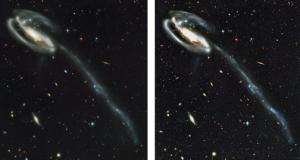APEX enhances Tadpole

Tadpole Galaxy
UGC 10214
ENLARGE Image
IMAGE TOUR
Credit:
Hubblesite gallery
_______________________________________________________
LEFT: Tadpole galaxy, imaged in 2002 by the Advanced Camera for Surveys (ACS) aboard NASA's Hubble Space Telescope, shows what NASA called a "Whitman's Sampler of galaxies" from the universe's 13-billion-year evolution. RIGHT: Applying the APEX method to the Tadpole galaxy image brings both "foreground" objects and background galaxies into significantly sharper focus. (Images courtesy of NASA/NIST)
Removing blur is a problem common to almost all imaging, from home snapshots to scientific instrumentation. Mathematically, blurring can be thought of as a set of mathematical operations that are applied to every point in an image and that result in that point being spread out and diffused. In principle, if you know the blurring function, the exact set of operations, you can remove the blur by delicate numerical analysis, being careful not to amplify noise.
But usually you don't know that. Many things go into blur--motion of the object, motion of the imager, irregularities in the optics, atmospheric effects ... the list goes on. As a rule, the precise mathematical transformation, the "point spread function," is unknown.
The APEX method was developed by mathematician Alfred Carasso as a general solution to a specific limited class of blur: blur that is symmetric and has certain other mathematical characteristics. APEX is based on a major simplifying assumption that leads to a big pay-off: it's fast and it's "blind" - it doesn't need to know the underlying point spread function in advance, but it can deduce it from the image.
Not every image is suitable for APEX enhancement because of its basic assumptions, but a remarkably large number are. At NIST, APEX originally was applied to deblurring images from scanning electron microscopes, and it also has been applied to some medical imaging.
In a recent paper, Carasso applied APEX to astronomical images, including color images from the Hubble Advanced Camera for Surveys (ACS), NASA's most advanced imaging system. Deblurring color images is even more involved, because the (still unknown) point spread function can be different for different color components.
APEX successfully detected and corrected unusual optical blurring functions in several astronomical images and delivered strikingly enhanced versions of well-known Hubble images, including the Whirlpool and Tadpole galaxies.
_______________________________________________________
APEX is not an acronym. A.S. Carasso. APEX blind deconvolution of color Hubble space telescope imagery and other astronomical data. Optical Engineering. 45, Number 10, October 2006, 107004
Source: National Institute of Standards and Technology December 11, 2006
_______________________________________________________
_______________________________________________________
Famous Quotes
There is more to life than increasing its speed. Mohandas Gandhi
Commerce is of trivial importance; Love, faith, truth of character,
and the aspiration of man, these are sacred. Ralph Waldo Emerson
_______________________________________________________
_______________________________________________________


<< Home